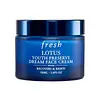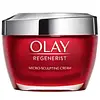What's inside
What's inside
 Key Ingredients
Key Ingredients

 Benefits
Benefits

 Concerns
Concerns

 Ingredients Side-by-side
Ingredients Side-by-side

Water
Skin ConditioningGlycerin
HumectantPropylene Glycol Dicaprylate/Dicaprate
EmollientButylene Glycol
HumectantCaprylic/Capric Triglyceride
MaskingPentylene Glycol
Skin ConditioningCetearyl Alcohol
EmollientC10-18 Triglycerides
EmollientDiglycerin
HumectantMyristyl Myristate
EmollientGlyceryl Stearate
EmollientButyrospermum Parkii Butter
Skin ConditioningNelumbo Nucifera Extract
Skin ConditioningPrunus Persica Leaf Extract
EmollientCitrus Limon Peel Oil
MaskingCucumis Sativus Fruit Extract
EmollientGlycine Soja Oil
EmollientHelianthus Annuus Seed Oil
EmollientTocopheryl Acetate
AntioxidantTocopherol
AntioxidantCetearyl Glucoside
EmulsifyingCaprylyl Glycol
EmollientAmmonium Acryloyldimethyltaurate/Vp Copolymer
Behenyl Alcohol
EmollientSodium Stearoyl Glutamate
CleansingCetyl Palmitate
EmollientCocoglycerides
EmollientAcrylates/C10-30 Alkyl Acrylate Crosspolymer
Emulsion StabilisingParfum
MaskingSodium Polyglutamate
HumectantSodium Hydroxide
Buffering1,2-Hexanediol
Skin ConditioningSodium Phytate
Chlorphenesin
AntimicrobialSodium Metabisulfite
AntioxidantPotassium Sorbate
PreservativeSodium Benzoate
MaskingLimonene
PerfumingCitral
PerfumingLinalool
PerfumingWater, Glycerin, Propylene Glycol Dicaprylate/Dicaprate, Butylene Glycol, Caprylic/Capric Triglyceride, Pentylene Glycol, Cetearyl Alcohol, C10-18 Triglycerides, Diglycerin, Myristyl Myristate, Glyceryl Stearate, Butyrospermum Parkii Butter, Nelumbo Nucifera Extract, Prunus Persica Leaf Extract, Citrus Limon Peel Oil, Cucumis Sativus Fruit Extract, Glycine Soja Oil, Helianthus Annuus Seed Oil, Tocopheryl Acetate, Tocopherol, Cetearyl Glucoside, Caprylyl Glycol, Ammonium Acryloyldimethyltaurate/Vp Copolymer, Behenyl Alcohol, Sodium Stearoyl Glutamate, Cetyl Palmitate, Cocoglycerides, Acrylates/C10-30 Alkyl Acrylate Crosspolymer, Parfum, Sodium Polyglutamate, Sodium Hydroxide, 1,2-Hexanediol, Sodium Phytate, Chlorphenesin, Sodium Metabisulfite, Potassium Sorbate, Sodium Benzoate, Limonene, Citral, Linalool
Water
Skin ConditioningGlycerin
HumectantIsohexadecane
EmollientNiacinamide
SmoothingIsopropyl Isostearate
EmollientAluminum Starch Octenylsuccinate
AbsorbentNylon-12
Dimethicone
EmollientPanthenol
Skin ConditioningTocopheryl Acetate
AntioxidantPalmitoyl Pentapeptide-4
Skin ConditioningSodium PEG-7 Olive Oil Carboxylate
EmulsifyingSodium Hyaluronate
HumectantCaprylic/Capric Triglyceride
MaskingCeratonia Siliqua Fruit Extract
MaskingStearyl Alcohol
EmollientPolyethylene
AbrasiveCetyl Alcohol
EmollientBehenyl Alcohol
EmollientSodium Acrylates Copolymer
Titanium Dioxide
Cosmetic ColorantBenzyl Alcohol
PerfumingMethylparaben
PreservativeEthylparaben
PreservativeDimethiconol
EmollientPolyacrylamide
Parfum
MaskingPEG-100 Stearate
Propylparaben
PreservativeCetearyl Glucoside
EmulsifyingCetearyl Alcohol
EmollientC13-14 Isoparaffin
EmollientDisodium EDTA
Citric Acid
BufferingStearic Acid
CleansingPalmitic Acid
EmollientC12-13 Pareth-3
EmulsifyingLaureth-7
EmulsifyingSodium Hydroxide
BufferingMica
Cosmetic ColorantWater, Glycerin, Isohexadecane, Niacinamide, Isopropyl Isostearate, Aluminum Starch Octenylsuccinate, Nylon-12, Dimethicone, Panthenol, Tocopheryl Acetate, Palmitoyl Pentapeptide-4, Sodium PEG-7 Olive Oil Carboxylate, Sodium Hyaluronate, Caprylic/Capric Triglyceride, Ceratonia Siliqua Fruit Extract, Stearyl Alcohol, Polyethylene, Cetyl Alcohol, Behenyl Alcohol, Sodium Acrylates Copolymer, Titanium Dioxide, Benzyl Alcohol, Methylparaben, Ethylparaben, Dimethiconol, Polyacrylamide, Parfum, PEG-100 Stearate, Propylparaben, Cetearyl Glucoside, Cetearyl Alcohol, C13-14 Isoparaffin, Disodium EDTA, Citric Acid, Stearic Acid, Palmitic Acid, C12-13 Pareth-3, Laureth-7, Sodium Hydroxide, Mica
 Reviews
Reviews

Ingredients Explained
These ingredients are found in both products.
Ingredients higher up in an ingredient list are typically present in a larger amount.
Behenyl Alcohol is a type of fatty alcohol (these are different from the drying, solvent alcohols).
Fatty Alcohols have hydrating properties and are most often used as an emollient or to thicken a product. They are usually derived from natural fats and oils; behenyl alcohol is derived from the fats of vegetable oils.
Emollients help keep your skin soft and hydrated by creating a film that traps moisture in.
In 2000, Behenyl Alcohol was approved by the US as medicine to reduce the duration of cold sores.
Learn more about Behenyl AlcoholThis ingredient is an emollient, solvent, and texture enhancer. It is considered a skin-softener by helping the skin prevent moisture loss.
It helps thicken a product's formula and makes it easier to spread by dissolving clumping compounds.
Caprylic Triglyceride is made by combining glycerin with coconut oil, forming a clear liquid.
While there is an assumption Caprylic Triglyceride can clog pores due to it being derived from coconut oil, there is no research supporting this.
Learn more about Caprylic/Capric TriglycerideCetearyl alcohol is a mixture of two fatty alcohols: cetyl alcohol and stearyl alcohol. It is mainly used as an emulsifier. Emulsifiers help prevent the separation of oils and products. Due to its composition, it can also be used to thicken a product or help create foam.
Cetearyl alcohol is an emollient. Emollients help soothe and hydrate the skin by trapping moisture.
Studies show Cetearyl alcohol is non-toxic and non-irritating. The FDA allows products labeled "alcohol-free" to have fatty alcohols.
This ingredient is usually derived from plant oils such as palm, vegetable, or coconut oils. There is debate on whether this ingredient will cause acne.
Due to the fatty acid base, this ingredient may not be Malassezia folliculitis safe.
Learn more about Cetearyl AlcoholCetearyl Glucoside is a surfactant and emulsifier. It can be produced from synthetic of natural sources of cetearyl alcohol and glucose.
Emulsifiers help prevent ingredients from separating, such as oils and waters. It can also be used to enhance the texture of products.
As a surfactant, Cetearyl Glucoside helps during the cleansing process. By gathering all the dirt and oils, it allows these molecules to be washed away easily.
Learn more about Cetearyl GlucosideGlycerin is already naturally found in your skin. It helps moisturize and protect your skin.
A study from 2016 found glycerin to be more effective as a humectant than AHAs and hyaluronic acid.
As a humectant, it helps the skin stay hydrated by pulling moisture to your skin. The low molecular weight of glycerin allows it to pull moisture into the deeper layers of your skin.
Hydrated skin improves your skin barrier; Your skin barrier helps protect against irritants and bacteria.
Glycerin has also been found to have antimicrobial and antiviral properties. Due to these properties, glycerin is often used in wound and burn treatments.
In cosmetics, glycerin is usually derived from plants such as soybean or palm. However, it can also be sourced from animals, such as tallow or animal fat.
This ingredient is organic, colorless, odorless, and non-toxic.
Glycerin is the name for this ingredient in American English. British English uses Glycerol/Glycerine.
Learn more about GlycerinParfum is a catch-all term for an ingredient or more that is used to give a scent to products.
Also called "fragrance", this ingredient can be a blend of hundreds of chemicals or plant oils. This means every product with "fragrance" or "parfum" in the ingredients list is a different mixture.
For instance, Habanolide is a proprietary trade name for a specific aroma chemical. When used as a fragrance ingredient in cosmetics, most aroma chemicals fall under the broad labeling category of “FRAGRANCE” or “PARFUM” according to EU and US regulations.
The term 'parfum' or 'fragrance' is not regulated in many countries. In many cases, it is up to the brand to define this term.
For instance, many brands choose to label themselves as "fragrance-free" because they are not using synthetic fragrances. However, their products may still contain ingredients such as essential oils that are considered a fragrance by INCI standards.
One example is Calendula flower extract. Calendula is an essential oil that still imparts a scent or 'fragrance'.
Depending on the blend, the ingredients in the mixture can cause allergies and sensitivities on the skin. Some ingredients that are known EU allergens include linalool and citronellol.
Parfum can also be used to mask or cover an unpleasant scent.
The bottom line is: not all fragrances/parfum/ingredients are created equally. If you are worried about fragrances, we recommend taking a closer look at an ingredient. And of course, we always recommend speaking with a professional.
Learn more about ParfumSodium Hydroxide is also known as lye or caustic soda. It is used to adjust the pH of products; many ingredients require a specific pH to be effective.
In small amounts, sodium hydroxide is considered safe to use. However, large amounts may cause chemical burns due to its high alkaline.
Your skin has a natural pH and acid mantle. This acid mantle helps prevent harmful bacteria from breaking through. The acid mantle also helps keep your skin hydrated.
"Alkaline" refers to a high pH level. A low pH level would be considered acidic.
Learn more about Sodium HydroxideTocopheryl Acetate is AKA Vitamin E. It is an antioxidant and protects your skin from free radicals. Free radicals damage the skin by breaking down collagen.
One study found using Tocopheryl Acetate with Vitamin C decreased the number of sunburned cells.
Tocopheryl Acetate is commonly found in both skincare and dietary supplements.
Learn more about Tocopheryl AcetateWater. It's the most common cosmetic ingredient of all. You'll usually see it at the top of ingredient lists, meaning that it makes up the largest part of the product.
So why is it so popular? Water most often acts as a solvent - this means that it helps dissolve other ingredients into the formulation.
You'll also recognize water as that liquid we all need to stay alive. If you see this, drink a glass of water. Stay hydrated!
Learn more about Water